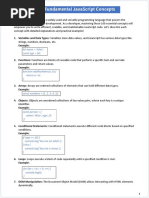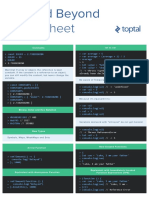Understanding JavaScript Objects
Uploaded by
nasheetk18Understanding JavaScript Objects
Uploaded by
nasheetk18©️HackNow Call/WhatsApp: +91 8984988593 Visit Us: https://hacknow.co.
in
Basic Object Creation
const car = {
make: "Toyota",
model: "Camry",
year: 2020
};
Explanation: This creates an object named car with three
properties: make, model, and year.
2. Accessing Object Properties
const person = { name: "Alice", age: 30, city: "New
York" };
console.log(person.age); // Output: 30
Explanation: You can access the age property using dot
notation.
3. Updating Object Properties
person.city = "Los Angeles";
console.log(person.city); // Output: Los Angeles
Explanation: You can update the city property by assigning a
new value.
4. Adding New Properties
person.occupation = "Engineer";
console.log(person.occupation); // Output: Engineer
Explanation: You can add a new property to an object by simply
assigning a value to a new key.
©️HackNow Call/WhatsApp: +91 8984988593 Visit Us: https://hacknow.co.in
©️HackNow Call/WhatsApp: +91 8984988593 Visit Us: https://hacknow.co.in
5. Deleting Properties
delete person.age;
console.log(person.age); // Output: undefined
Explanation: The delete operator removes a property from an
object.
6. Object Methods
const personWithFullName = {
firstName: "John",
lastName: "Doe",
getFullName: function() {
return `${this.firstName}
${this.lastName}`;
}
};
console.log(personWithFullName.getFullName()); //
Output: John Doe
Explanation: This defines a method getFullName that
returns the full name by accessing firstName and
lastName.
©️HackNow Call/WhatsApp: +91 8984988593 Visit Us: https://hacknow.co.in
©️HackNow Call/WhatsApp: +91 8984988593 Visit Us: https://hacknow.co.in
7. Nested Objects
const student = {
name: "Bob",
age: 20,
grades: {
math: 90,
science: 85,
english: 88
}
};
Explanation: The grades property is an object containing
scores for different subjects.
8. Object Destructuring
const user = { id: 1, username: "john_doe", email:
"john@example.com" };
const { username, email } = user;
console.log(username, email); // Output: john_doe
john@example.com
Explanation: Destructuring allows you to extract properties from
an object into variables.
9. Checking Object Types
const data = {};
console.log(typeof data === 'object'); // Output:
true
Explanation: You can check if a variable is an object using
typeof.
©️HackNow Call/WhatsApp: +91 8984988593 Visit Us: https://hacknow.co.in
©️HackNow Call/WhatsApp: +91 8984988593 Visit Us: https://hacknow.co.in
10. Object.keys()
const carKeys = Object.keys(car);
console.log(carKeys); // Output: ["make", "model",
"year"]
Explanation: Object.keys() returns an array of the object's
property names.
11. Object.values()
const carValues = Object.values(car);
console.log(carValues); // Output: ["Toyota",
"Camry", 2020]
Explanation: Object.values() returns an array of the
object's property values.
12. Object.entries()
const carEntries = Object.entries(car);
console.log(carEntries); // Output: [["make",
"Toyota"], ["model", "Camry"], ["year", 2020]]
Explanation: Object.entries() returns an array of key-
value pairs.
©️HackNow Call/WhatsApp: +91 8984988593 Visit Us: https://hacknow.co.in
©️HackNow Call/WhatsApp: +91 8984988593 Visit Us: https://hacknow.co.in
13. Merging Objects
const obj1 = { a: 1, b: 2 };
const obj2 = { b: 3, c: 4 };
const merged = { ...obj1, ...obj2 };
console.log(merged); // Output: { a: 1, b: 3, c: 4
}
Explanation: The spread operator (...) merges two objects,
with properties from the second object overwriting those from
the first.
14. Prototypes
function Animal(type) {
this.type = type;
this.speak = function() {
console.log(`${this.type} makes a sound.`);
};
}
const dog = new Animal("Dog");
dog.speak(); // Output: Dog makes a sound.
Explanation: This defines a constructor function Animal and
creates an instance dog.
©️HackNow Call/WhatsApp: +91 8984988593 Visit Us: https://hacknow.co.in
©️HackNow Call/WhatsApp: +91 8984988593 Visit Us: https://hacknow.co.in
15. Inheritance
function Dog(breed) {
Animal.call(this, "Dog"); // Call the parent
constructor
this.breed = breed;
}
Dog.prototype = Object.create(Animal.prototype);
const myDog = new Dog("Labrador");
console.log(myDog.type); // Output: Dog
console.log(myDog.breed); // Output: Labrador
myDog.speak(); // Output: Dog makes a sound.
Explanation: The Dog constructor calls the Animal
constructor to inherit the type property. The prototype of Dog
is set to an instance of Animal, allowing myDog to access
methods defined in Animal.
16. Object.freeze()
const frozenObject = Object.freeze({ name: "Alice",
age: 30 });
frozenObject.age = 31; // This will not change the
age property
console.log(frozenObject.age); // Output: 30
Explanation: Object.freeze() makes an object
immutable, meaning you cannot change its properties or add new
ones.
©️HackNow Call/WhatsApp: +91 8984988593 Visit Us: https://hacknow.co.in
©️HackNow Call/WhatsApp: +91 8984988593 Visit Us: https://hacknow.co.in
17. Object.seal()
const sealedObject = Object.seal({ name: "Bob",
age: 25 });
sealedObject.age = 26; // This will work
sealedObject.city = "New York"; // This will not
work
console.log(sealedObject); // Output: { name:
"Bob", age: 26 }
Explanation: Object.seal() allows existing properties to
be modified but prevents new properties from being added.
18. Checking for Property Existence
if ('occupation' in person) {
console.log("Occupation exists");
} else {
console.log("Occupation does not exist"); //
Output: Occupation does not exist
}
Explanation: The in operator checks if a property exists in an
object.
©️HackNow Call/WhatsApp: +91 8984988593 Visit Us: https://hacknow.co.in
©️HackNow Call/WhatsApp: +91 8984988593 Visit Us: https://hacknow.co.in
19. Iterating Over Object Properties
for (const key in student) {
if (student.hasOwnProperty(key)) {
console.log(`${key}: ${student[key]}`);
}
}
// Output:
// name: Bob
// age: 20
// grades: [object Object]
Explanation: A for...in loop iterates over the properties of
an object. The hasOwnProperty method ensures that only
the object's own properties are logged.
20. JSON and Objects
const jsonString = JSON.stringify(person);
console.log(jsonString); // Output:
{"name":"Alice","city":"Los
Angeles","occupation":"Engineer"}
const parsedObject = JSON.parse(jsonString);
console.log(parsedObject); // Output: { name:
"Alice", city: "Los Angeles", occupation:
"Engineer" }
Explanation: JSON.stringify() converts an object to a
JSON string, while JSON.parse() converts a JSON string back
into an object.
©️HackNow Call/WhatsApp: +91 8984988593 Visit Us: https://hacknow.co.in
You might also like
- Guide de cours et TPs - M204 - React JS - Nov 2024No ratings yetGuide de cours et TPs - M204 - React JS - Nov 2024158 pages
- 12 JavaScript Concepts That Will Level Up Your Development Skills - Hacker NoonNo ratings yet12 JavaScript Concepts That Will Level Up Your Development Skills - Hacker Noon33 pages
- A Comprehensive Guide to JavaScript Objects - Part 2No ratings yetA Comprehensive Guide to JavaScript Objects - Part 24 pages
- 3JS-Part3 Objects, Properties, And Methods of the DOMNo ratings yet3JS-Part3 Objects, Properties, And Methods of the DOM85 pages
- ASSESSMENT PART 3 (Updated)_Andrew BaldonadoNo ratings yetASSESSMENT PART 3 (Updated)_Andrew Baldonado13 pages
- Important Javascript Build-In Methods (Cheatsheet)No ratings yetImportant Javascript Build-In Methods (Cheatsheet)10 pages
- JavaScript Essentials for Technical InterviewsNo ratings yetJavaScript Essentials for Technical Interviews226 pages
- A Comprehensive Guide to JavaScript Objects - Part 1No ratings yetA Comprehensive Guide to JavaScript Objects - Part 14 pages
- Advanced Javascript: Arrow Functions, Template Literals, Array DestructingNo ratings yetAdvanced Javascript: Arrow Functions, Template Literals, Array Destructing9 pages
- Design and Throat Optimization of Double Parabolic Supersonic Nozzle at Different Operating ConditionsNo ratings yetDesign and Throat Optimization of Double Parabolic Supersonic Nozzle at Different Operating Conditions22 pages
- Trickle Irrigation System Components and LayoutNo ratings yetTrickle Irrigation System Components and Layout8 pages
- Thomas Edison Inventor of The Electric Light BulbNo ratings yetThomas Edison Inventor of The Electric Light Bulb3 pages
- Annual Survey Checklist For Oil Chemical TankerNo ratings yetAnnual Survey Checklist For Oil Chemical Tanker11 pages
- 30 MWSri Gomathi Energy Technical TenderspecificationsNo ratings yet30 MWSri Gomathi Energy Technical Tenderspecifications235 pages

























































































